While Wednesday’s rally was one of the sharpest on record, stocks are still well below this year’s highs, mainly due to tariff turmoil and the escalating global trade war. A combination of economic pressures and market dynamics directly impacts the energy sector. The primary drivers include declining oil prices; WTI has fallen approximately 18% from January highs through Wednesday’s close due to fears of reduced global demand, alongside rising operational costs. Tariffs on imports from major trading partners, such as China, Canada, and the European Union, disrupt global supply chains and increase business costs. Reducing consumer spending and industrial activity —both significant energy consumers — diminishes the demand for oil and gas. This decline severely impacts the revenues of energy companies, particularly those involved in oil production and exploration. @CL.1 1Y mountain WTI crude, 1 year The trade war introduces uncertainty that spooks investors and slows trade, increasing the risk of recession for a fragile economy. Recessions typically hurt revenues and operating margins, and the multiple investors are willing to pay for a business — creating lousy news for stocks. E & P companies (exploration and production) like APA Corporation have declined far more than the market overall, and this is after years of underperformance. A buyer of APA shares on May 21, 2008, at the all-time highs, would have lost nearly 85% as of today’s close (which was, somewhat astonishingly, more than 20% higher than Wednesday’s lows.) This wild intraday swing reveals that Investor concerns might be overdone if tariffs prove temporary or negotiable and if energy demand holds up domestically. It also demonstrates that companies like APA may have enormous upside beta if the market rebounds and might be an interesting long-side play to get asymmetric upside on market rebounds. Sell-side analysts are not enthusiastic about the sector, citing OPEC+’s production increases and the intensifying trade war, which are putting pressure on oil prices. APA is a relatively diversified investment with multinational exposure. Egypt represents 30% of the company’s revenues, while about 10% comes from the North Sea. Expected declines in first-quarter production and projected increases in capital expenditure in the Permian, Suriname, and Alaska, along with the absence of hedges as crude prices fall, contribute to the overall lack of enthusiasm. The anticipated realized oil price is expected to exceed $71 per barrel, whereas the current price has fallen below $60 today as the stock reached 52-week lows. APA YTD mountain APA, YTD However, all this bad news may present an opportunity. Operating margins have remained fairly consistent, excluding the pandemic-related collapse in crude prices. Even if we assume the company earns half of what the street is forecasting (it should be discounted, as crude prices have fallen), it would be trading at only 10 times earnings. At 80% of last year’s free cash flow, the company would have a free cash flow yield of approximately 10%. Again, one should apply a substantial haircut to the forecasts which haven’t been meaningfully updated as crude prices fell. It’s clear that a lot of bad news is already priced into the stock. The trade One can sell the May 23 $14 strike put for approximately $1.35. In the event that you are assigned the stock, it also provides a roughly 6% annual dividend yield, which could be enhanced even further with covered calls while premiums remain elevated. If economic clouds lift, this isn’t a bad name to own, even without the overlay. Get Your Ticket to Pro LIVE Join us at the New York Stock Exchange! Uncertain markets? Gain an edge with CNBC Pro LIVE , an exclusive, inaugural event at the historic New York Stock Exchange. In today’s dynamic financial landscape, access to expert insights is paramount. As a CNBC Pro subscriber, we invite you to join us for our first exclusive, in-person CNBC Pro LIVE event at the iconic NYSE on Thursday, June 12. Join interactive Pro clinics led by our Pros Carter Worth, Dan Niles, and Dan Ives, with a special edition of Pro Talks with Tom Lee. You’ll also get the opportunity to network with CNBC experts, talent and other Pro subscribers during an exciting cocktail hour on the legendary trading floor. Tickets are limited! DISCLOSURES: (Sold the put discussed) All opinions expressed by the CNBC Pro contributors are solely their opinions and do not reflect the opinions of CNBC, NBC UNIVERSAL, their parent company or affiliates, and may have been previously disseminated by them on television, radio, internet or another medium. THE ABOVE CONTENT IS SUBJECT TO OUR TERMS AND CONDITIONS AND PRIVACY POLICY . THIS CONTENT IS PROVIDED FOR INFORMATIONAL PURPOSES ONLY AND DOES NOT CONSITUTE FINANCIAL, INVESTMENT, TAX OR LEGAL ADVICE OR A RECOMMENDATION TO BUY ANY SECURITY OR OTHER FINANCIAL ASSET. THE CONTENT IS GENERAL IN NATURE AND DOES NOT REFLECT ANY INDIVIDUAL’S UNIQUE PERSONAL CIRCUMSTANCES. THE ABOVE CONTENT MIGHT NOT BE SUITABLE FOR YOUR PARTICULAR CIRCUMSTANCES. BEFORE MAKING ANY FINANCIAL DECISIONS, YOU SHOULD STRONGLY CONSIDER SEEKING ADVICE FROM YOUR OWN FINANCIAL OR INVESTMENT ADVISOR. Click here for the full disclaimer.





